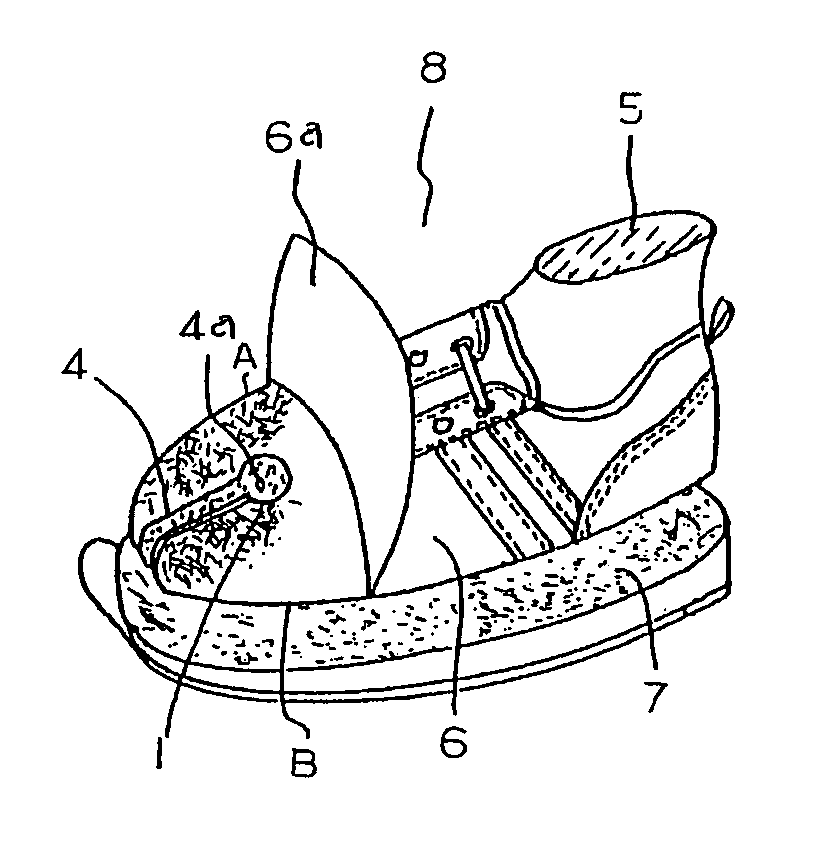Footwear of shoe structure
a technology of shoe structure and shoe, applied in the field of shoe structure, can solve the problems of not being suitable for general sports and going out, not having any effect on a person whose large toe has been deformed, and not being suitable for many hours of wear, etc., to achieve the effect of convenient wear, simple and easy fitting, and less tiring
- Summary
- Abstract
- Description
- Claims
- Application Information
AI Technical Summary
Benefits of technology
Problems solved by technology
Method used
Image
Examples
example 1
[0024]A running shoe will be explained as an example of the invention reference to drawings.
[0025]FIG. 1 is a perspective view of a special internal structure of the invention, namely an internal structure 1 of a half-size tabi inserted into the toe of a shoe. Here, the upper part A of the internal structure 1 is formed of two sheets 1a, 1b comprising stretchable cloth of nylon or Dacron knitted material, with a urethane foam 1c interposed therebetween. The thickness t thereof is 2 mm to 5 mm. As shown in the drawing, a crotch part 2 is formed in a toe part p so as to partition the big toe and the other four toes of a foot at an adequate interval.
[0026]The lower part B of the internal structure 1 is formed in a two-sheet structure in which a face in contact with the inside of the sole is formed of a synthetic fiber flat weave cloth 1e whose stretch is inferior to the that of the upper part A (which can even be non-stretchable), an insole surface is formed of a stretchable nylon tric...
example 2
[0035]FIG. 7 is a perspective view, with a portion of an instep covering material lifted, of a safety shoe 9 of the invention. The safety shoe 9 has a box toe member 10 in the toe as a protection member. As shown in figure, the box toe member 10 is interposed between the instep covering material 6 and the internal structure 1. Specifically, the upper cloth 1a of the internal structure 1 is firmly fitted into the safety shoe 9 by being fixed on the inside of the box toe member 10 by an adhesive agent. Therefore, while keeping the safety feature of the box toe member 10, the safety shoe 9 has effects on the stoppage of the advance of hallux vulgas and the correction of hallux vulgas due to the internal structure 1, as in the case of Example 1. Well-known structures for protecting the toe, such as steel sheets or fiber-reinforced plastics, can be used as the box toe member 10.
[0036]In the above-mentioned examples, although a running shoe and a safety shoe are respectively explained, th...
PUM
 Login to View More
Login to View More Abstract
Description
Claims
Application Information
 Login to View More
Login to View More - R&D
- Intellectual Property
- Life Sciences
- Materials
- Tech Scout
- Unparalleled Data Quality
- Higher Quality Content
- 60% Fewer Hallucinations
Browse by: Latest US Patents, China's latest patents, Technical Efficacy Thesaurus, Application Domain, Technology Topic, Popular Technical Reports.
© 2025 PatSnap. All rights reserved.Legal|Privacy policy|Modern Slavery Act Transparency Statement|Sitemap|About US| Contact US: help@patsnap.com



